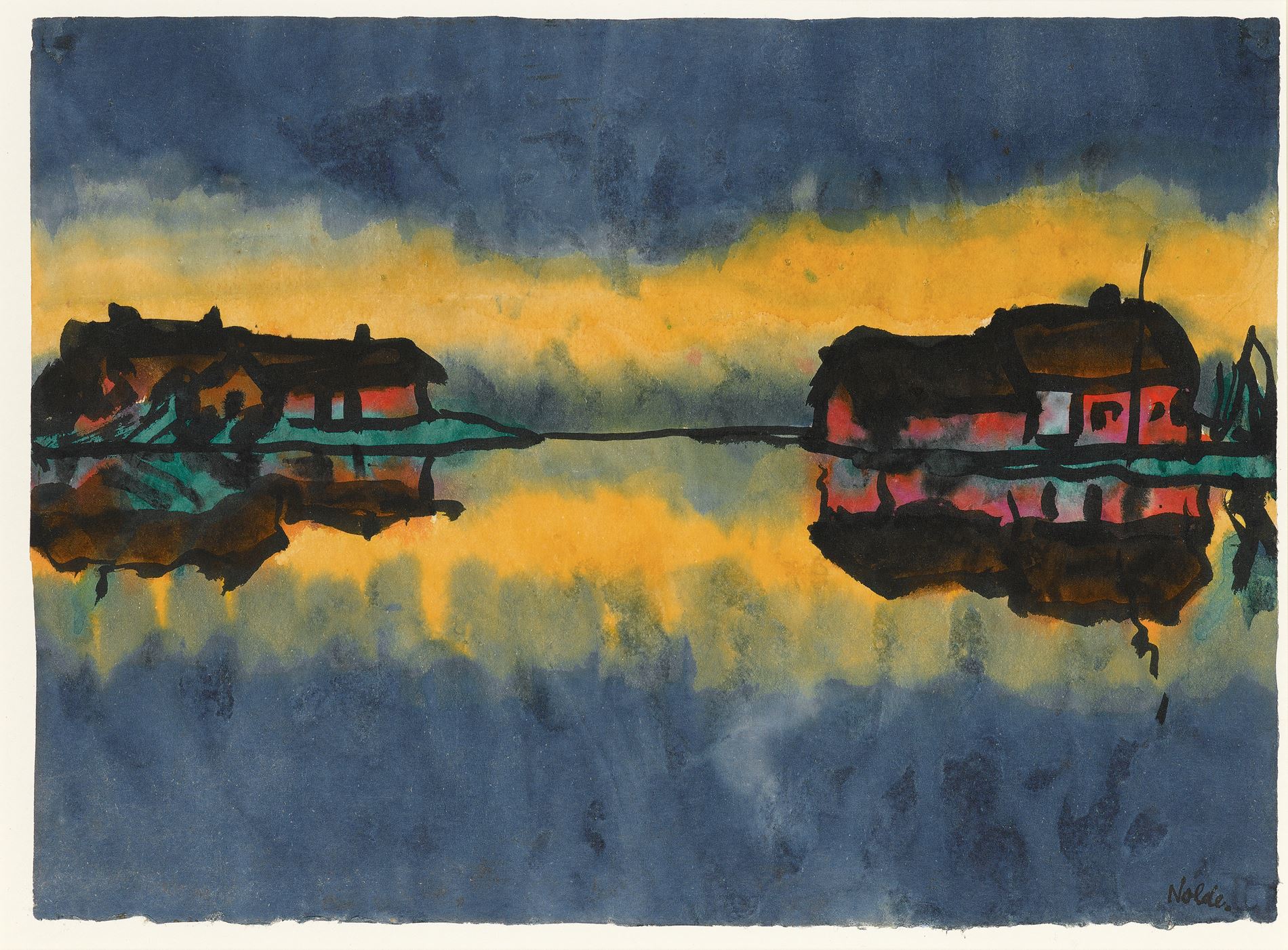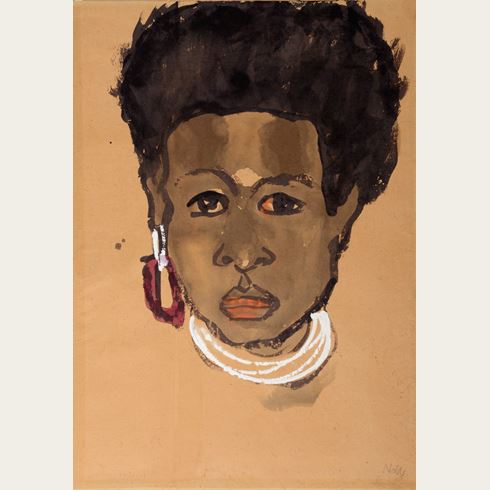Emil NOLDE
(Nolde 1867 - Seebüll 1956)
Marsh Landscape with Farmhouses at Utenwarf
Sold
Watercolour, brush and black ink on thin Japan paper, laid down on card. Signed Nolde. at the lower right.
346 x 473 mm. (13 5/8 x 18 5/8 in.)
346 x 473 mm. (13 5/8 x 18 5/8 in.)
One of Nolde’s favourite subjects were the low-lying marsh landscapes of the border province of North Schleswig, where he was born and raised. In 1912 he had purchased a farmhouse, named ‘Utenwarf’, in just such a marshy landscape, near the town of Tondern (now a part of Denmark) and not far from Nolde, the village of his birth. In 1926 he moved a few kilometres south and west to Seebüll, where he designed a house and studio in which he lived and worked for the rest of his life.
As has been noted of Nolde, ‘he felt a profound, almost spiritual attachment to his native land, by which he meant that flat landscape of dykes and marshes penned in between the North Sea and the hilly coastal area to the East, giving on to the Baltic – a region which is his own day marked the disputed border between Germany and Denmark. It was this locality…which provided him with not merely spiritual nourishment but also by far the most significant repertoire of motifs and subjects: the fields and pastures that surrounded the isolated farmhouses of his nearest neighbours, clouds and sea, flowers and gardens...Nolde invests his landscapes with an undisguised symbolic significance, exploiting marshes and fields, clouds and sky as metaphors for the awesome power of nature and the eternal confrontation between man in his natural state and the elements.’ Nolde’s views of these wide expanses of marshland, with isolated farmhouses dwarfed by high skies above a low horizon, account for much of his most appealing work.
The present sheet displays the luminous intensity of colour that is a particular characteristic of Nolde’s finest watercolours. These often come close to abstraction in the repeated soaking of the paper with pigment that was a hallmark of the artist’s technique. Nolde’s second wife Jolanthe has left a fascinating account of his watercolour technique, noting that the artist applied colours ‘five, six or more times, producing the most remarkable effect of depth...patiently the brush caresses the surface, the wet paper cockles, the colour gradually accumulating in the little hollows...Because he painted with such diluted colours, the contours would stray across the surface of the paper for up to an hour before they were finally dry...He would paint, the paper would soak up the colour, the contours would spread as if the material had become liberated.’
As has been noted of Nolde, ‘he felt a profound, almost spiritual attachment to his native land, by which he meant that flat landscape of dykes and marshes penned in between the North Sea and the hilly coastal area to the East, giving on to the Baltic – a region which is his own day marked the disputed border between Germany and Denmark. It was this locality…which provided him with not merely spiritual nourishment but also by far the most significant repertoire of motifs and subjects: the fields and pastures that surrounded the isolated farmhouses of his nearest neighbours, clouds and sea, flowers and gardens...Nolde invests his landscapes with an undisguised symbolic significance, exploiting marshes and fields, clouds and sky as metaphors for the awesome power of nature and the eternal confrontation between man in his natural state and the elements.’ Nolde’s views of these wide expanses of marshland, with isolated farmhouses dwarfed by high skies above a low horizon, account for much of his most appealing work.
The present sheet displays the luminous intensity of colour that is a particular characteristic of Nolde’s finest watercolours. These often come close to abstraction in the repeated soaking of the paper with pigment that was a hallmark of the artist’s technique. Nolde’s second wife Jolanthe has left a fascinating account of his watercolour technique, noting that the artist applied colours ‘five, six or more times, producing the most remarkable effect of depth...patiently the brush caresses the surface, the wet paper cockles, the colour gradually accumulating in the little hollows...Because he painted with such diluted colours, the contours would stray across the surface of the paper for up to an hour before they were finally dry...He would paint, the paper would soak up the colour, the contours would spread as if the material had become liberated.’
Born Emil Hansen, Emil Nolde took his name of his birthplace, on the border of Germany and Demmark, in 1902. He grew up and spent much of his life in the province of Schleswig-Holstein, and apart from some time spent in Berlin was never far from the sea. His first studio was a hut on the beach on the island of Alsen, where he spent summers beginning in 1903, and there he delighted in observing the sea at close hand. This obsession with the sea and its power was to remain with him throughout his career, and provided the inspiration for a large number of paintings and watercolours. He was briefly a member of the expressionist group Die Brücke (The Bridge) in 1906-1907 and the Berlin Secession between 1908 and 1910, but eventually left both groups. He also exhibited with the Der Blauer Reiter (The Blue Rider) group in 1912, although he was never a member.
Despite being a successful and highly regarded artist, Nolde found himself, at the age of seventy, crushed by the Nazi party’s official condemnation of modernism in art. In 1937 he was declared a ‘degenerate’ artist by the Nazis, and nearly fifty of his works were included in the Entartete Kunst (‘Degenerate Art’) exhibition held that year. More than a thousand of his works – more than those of any other artist - were confiscated from museums and private collections, as well as from his studio, and many of his paintings and drawings were destroyed. In 1941 he was expelled from the Reichskunstkammer (the Reich Chamber of Art), and was forbidden to paint, even in private; he was also prohibited from exhibiting or selling his work. As a result he turned towards working on paper, producing a large number of small watercolours and gouaches that he referred to as his ‘unpainted pictures’.
Nolde produced watercolours almost continuously from around 1908 onwards, and the medium would come to dominate his output over oil paintings. As one scholar has noted, ‘Numerically...it is the watercolours which occupy pride of place in his oeuvre: indeed, he can claim to have been one of the most prolific watercolourists of the twentieth century – one of the relatively few modern artists to devote such close attention to what seemed to many an old-fashioned medium. In his hands, watercolour revealed new possibilities...It was the medium to which he would confide his most intimate thoughts...It was also the one in which he felt most thoroughly at home.’
Nolde’s watercolours are characterized by a technical proficiency and a preference for the finest materials. He would occasionally use tempera colours rather than watercolour, to achieve greater permanence, diluting the tempera with water. He painted ‘wet on wet’, using very wet brushes and large amounts of diluted colour to soak the highly absorbent, translucent Japanese paper he preferred - at times, he would even apply colour to the back of a sheet and let it bleed through to the recto – so that the colour took on a particular intensity, as if it were in the paper itself rather than lying on the surface.
Provenance
Marlborough Fine Art, New York
Albert Otten, New York and Teaneck, New Jersey
By descent to his widow, Mildred Otten, Teaneck, New Jersey
Galerie Cazeau-Béraudière, Paris, in 2005
Galerie Jacques de la Béraudière, Geneva.





